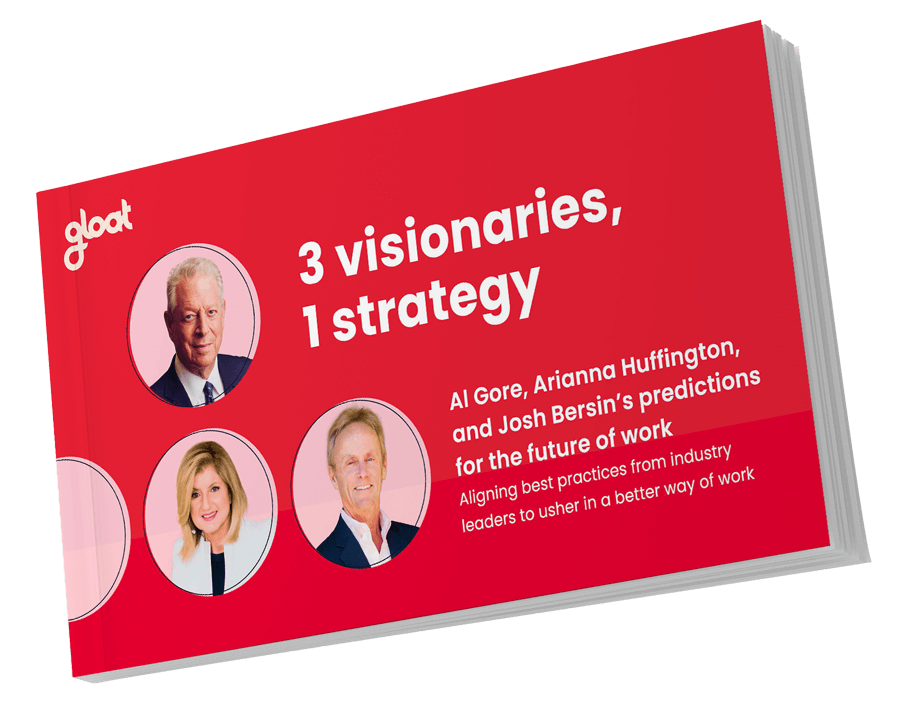Defying disruption: successful strategies to build and sustain workforce resilience
Learn how to steer your organization toward success amidst ongoing disruption The 2020s have already earned their nickname as “the decade of disruption”. We’ve seen the world respond to an unprecedented global pandemic, embrace hybrid and remote working, grapple with market uncertainty, and adopt cutting-edge AI innovations—and we’re not even halfway through the decade yet.

Learn how to steer your organization toward success amidst ongoing disruption
The 2020s have already earned their nickname as “the decade of disruption”. We’ve seen the world respond to an unprecedented global pandemic, embrace hybrid and remote working, grapple with market uncertainty, and adopt cutting-edge AI innovations—and we’re not even halfway through the decade yet.
By now, most leaders recognize that traditional working models that were built for stability and efficiency no longer cut it. Now that our world is ever-evolving and uncertain, businesses must embrace new practices that help their organizations thrive in the face of disruption.
The most effective strategies take a flexible approach in which talent is reallocated based on skills, rather than sticking to rigid job-centric hierarchies. In addition to unlocking agility, these skills-based strategies are essential for helping organizations achieve workforce resilience.
What is workforce resilience?
Resilience is about your ability to recover or adapt quickly and easily to adversity and change. In the context of a workforce, the term is used to describe how well your employees can respond to challenges and shift gears when priorities change and new obstacles emerge.
Achieving workforce resilience comes down to two core elements: cultivating a culture that inspires people and empowers them to continuously build new skills and ensuring your workforce has the technology and systems needed to accomplish business priorities as they evolve. The most resilient organizations generally take a skills-based approach to talent management, aligning employees to open projects and tasks based on their capabilities and capacity.
The importance of workforce resilience
While workforce resilience has always given companies an edge, it’s increasingly essential now that our working world is moving faster. Every company is embarking on digital transformation initiatives that require employees to hone new skills and embrace new ways of working. In response to these shifting skill needs and accelerated pace of innovation, organizations must be adaptive and agile.
Resilient organizations can reallocate talent to respond to shifting priorities, create cultures that help employees feel safe and empowered, and tap into all of their workforce’s skills to create innovative solutions to pressing challenges. In contrast, companies that lack resilience will not only suffer bottom-line losses but also struggle to maintain morale amongst employees.
Key components of workforce resilience
Workforce resilience encompasses many different characteristics and important patterns. Resilient businesses are composed of people who are committed to continuously learning and developing their skill sets. They cultivate a supportive culture in which employees are empowered to take on new opportunities and reach out to their colleagues whenever they’re looking for guidance or support.
Leaders at these organizations prioritize transparency and empathy and ensure their people have the knowledge needed to help their businesses pivot ahead of the curve. These companies also develop digital infrastructures that are dynamic and AI-powered to support the work their people are doing.
How workforce resilience is evolving
Workforce resilience has always been important, but it’s reaching a new level of significance in our Post-Industrial era of work. Amidst widening skill gaps and the accelerated pace of digital innovation, companies must learn to strategically shift gears and execute do-or-die pivots to keep up with ongoing economic uncertainty and evolving consumer demands.
In addition to market turbulence, executives are also navigating talent landscape changes that have never been seen before. While each industry was once a stable and predictable group of businesses with similar operating models, these lines are now crossed. Today, every company is a technology company. From healthcare organizations that want to deliver online consultations to oil enterprises that are under pressure to get into new sources of energy, market convergence is changing businesses’ skill and talent needs.
Technology is an increasingly crucial component of the workforce resilience equation, particularly as work becomes more digitized and hybrid. The caliber of tools and platforms your workforce uses can make or break resilience; if employees struggle to access systems or lack visibility into professional development opportunities, it will hinder your workforce’s ability to effectively respond to new challenges.
Leadership also plays a big role in determining how resilient your workforce is. When executives are empathetic, decisive, and communicate transparently, employees will feel better equipped to handle various disruptions. In contrast, leaders who struggle to communicate and update their workforces may lack the support needed to successfully respond to future challenges.
5 steps to build a more resilient workforce
If you’re looking to help your organization increase its workforce resilience, here are a few steps HR leaders can take:
#1. Take stock of skills
Skill gaps are heading in the wrong direction, which poses a serious threat to business success. By 2030, Korn Ferry predicts there will be a human talent shortage of more than 85 million people, which could result in about $8.5 trillion in unrealized annual revenues. Rather than missing out on these earnings, companies can proactively address future talent gaps by taking stock of skills now. Leaders need clear insight into all of their peoples’ capabilities, which isn’t always easy to come by.
Skills information is usually siloed among a few different HR systems, making it difficult for executives to get a single source of truth. To make matters worse, skills taxonomies are often out of date, leading to skill-building strategies that may not address the actual needs of the organization.
Companies that are looking to level up resilience are turning to skills intelligence tools like Gloat’s Skills Foundation to gain visibility into all of their peoples’ capabilities. These systems are updated in real-time and pull from a worker’s LinkedIn profile or CV, in turn capturing the full range of expertise they’re bringing to the table.
#2. Identify emerging knowledge needs
Once leaders have a clear picture of the skills they’re working with, they must turn their attention towards the future and figure out what capabilities their people will need to build to prepare their organization for future challenges.
Predicting which competencies will be crucial down the line is challenging, but skills intelligence tools can provide forecasting based on internal and market data. The best tools show which skills are on the rise, and which are declining, and shed light on any emerging knowledge gaps so leaders can come up with a plan to bridge them. Effective skill-building strategies will include both content-based L&D courses as well as hands-on opportunities that give employees a chance to put the lessons they’re learning into practice.
#3. Develop leadership skills at all levels
Leadership skills are worth developing—even before employees move into management positions. Soft skills such as communication, conflict resolution, and coaching are valuable throughout a worker’s career and can help more junior employees navigate challenging situations thoughtfully.
Resilient workforces make strides to empower everyone to share their opinions and ideas, regardless of their seniority level. Josh Bersin advocates for this egalitarian approach—also known as a skills meritocracy—noting, “You’ve got to respect that employees might have the skills but maybe they’re young or they haven’t worked in the domain before. If you don’t have a skills meritocracy, then you end up with these silos and that’s a very traditional way of thinking that you’ll find in a lot of companies.”
#4. Prioritize a people-first employee experience strategy
Employees must feel positive about their workforce experience to go the extra mile to help their organizations succeed. According to Gartner, when employees report a positive employee experience they are 60% more likely to stay with the company and 52% more likely to report “high discretionary effort”, which is work they do above and beyond their daily responsibilities.
Organizations that wish to be resilient should go the extra mile to retain employees, particularly those with in-demand skills. Companies that suffer from high turnover rates will constantly need to make up for institutional knowledge that was lost and rebuild skill sets that their departing employees left with. Ensuring everyone has access to career development opportunities is a key component of creating a compelling employee experience; 67% of workers claim they would quit their jobs if internal mobility wasn’t offered.
#5. Move away from a hierarchical mindset
While rigid hierarchies and strictly defined jobs may have made sense in a working world that was predictable and stable, this approach to work won’t hold up in an era of ongoing disruption. Rather than confining employees to the roles they were hired to do, skills-based organizations empower workers to take on an array of responsibilities by matching people to open opportunities based on the skills they possess. Many companies use a talent marketplace to seamlessly align employees to projects, gigs, and full-time roles that align with their skills and goals, as well as the needs of the business.
How to measure workforce resilience: metrics and KPIs
Workforce resilience isn’t built overnight. Instead, it takes ongoing efforts and a comprehensive strategy to ensure your organization is future-ready and equipped to tackle whatever challenges come your way.
There are several metrics leaders can look to measure the efficacy of their approach. Employee engagement scores and feedback surveys can reveal how your people feel about the changes your organization is making and their confidence in their ability to navigate future changes. Executives can also assess employee turnover rates and time to adapt to new roles to get a sense of how agile and engaged their people are.
Finally, metrics that measure productivity—such as unlocked hours of capacity—can help leaders gauge how efficiently their organization functions. The more hours you can unlock, the more time employees will have to learn new skills that will prepare them for the next set of obstacles they’ll encounter.
If you’re looking for expert advice on how to prepare for the future of work, check out our guide 3 visionaries, 1 strategy, which includes top tips from Arianna Huffington, Al Gore, and Josh Bersin.





